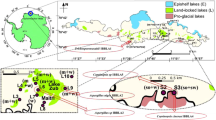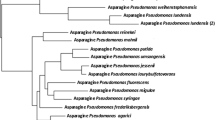Abstract
Objectives
To screen soil metagenomic libraries for novel enzymes with enhanced activities.
Results
To screen soil metagenomic libraries for novel enzymes with enhanced activities. A novel l-asparaginase was identified from forest soil metagenome and its characteristics were studied. The purified protein had a specific activity of 696 IU mg−1 and optimum activity at pH 7 and 35 °C. Enhanced enzyme activities were observed in the presence of Mg2+, Ca2+ and K+. The Km value, 2 mM, and enzyme specificity constant 7.7 mM−1s−1 indicated that the recombinant enzyme has good substrate affinity to l-asparagine compared with commercially-available Escherichia coli asparaginase. The IC50 value of 0.78 µg ml−1 (0.47 IU ml−1) was observed with HL60 cell line and 0.39 µg ml−1(0.23 IU ml−1) with MOLT-3 and MOLT-4 cell lines, which is better than that of commercially-available drugs.
Conclusion
The soil metagenome derived l-asparaginase with enhanced activities could be a potential candidate to develop as a drug in Acute Lymphoblastic Leukemia (ALL) therapy.


Similar content being viewed by others
References
Avarmis VI, Tiwari PN (2006) Asparaginase (native ASNase pegylatedASNase) in the treatment of acute lymhoblastic leukemia. Int J Nanomed 1:241–254
Button DK, Robertson BR (2001) Determination of DNA content of aquatic bacteria by flow cytometry. Appl Environ Microbiol 67:1636–1645
Deokar VD, Vetal MD, Rodrigues L (2010) Production of intracellular l-asparaginase from Erwinia carotovora and its statistical optimization using response surface methodology. Int J Chem Sci Appl 1:25–36
Desai C, Madamwar D (2007) Extraction of inhibitor free metagenomic DNA from polluted sediments, compatible with molecular diversity analysis using adsorption and ion-exchange treatments. Bioresour Technol 98:761–768
Gabor EM, Alkema WB, Janssen DB (2004) Quantifying the accessibility of the metagenome by random expression cloning techniques. Environ Microbiol 6:879–886
Gillespie DE, Brady SF, Bettermann AD, Cianciotto NP, Liles MR, Rondon MR, Clardy J, Goodman RM, Handelsman J (2002) Isolation of antibiotics turbomycin A and B from a metagenomic library of soil microbial DNA. Appl Environ Microbiol 68:4301–4306
Hendriksen HV, Kornbrust BA, Ostergaard PR, Stringer MA (2009) Evaluating the potential for enzymatic acrylamide mitigation in a range of food products using an asparaginase from Aspergillus oryzae. J Agric Food Chem 57:4168–4176
Kondrat’eva NA, Dobrynin I, Merkulov MF (1978) Biological properties of l-asparaginase preparations from E. coli in cell cultures. Antibiotiki 23:43–45
Kumar S, Guru SK, Pathania AS, Kumar A, Bhushan S, Malik F (2013) Autophagy triggered by magnolol derivative negatively regulates angiogenesis. Cell Death Dis 4:e889
Kumar S, Stecher G, Tamura K (2016) MEGA7: Molecular Evolutionary Genetics Analysis version 7.0 for bigger datasets. Mol Biol Evol 33:1870–1874
Mahajan RV, Kumar V, Rajendran V, Saran S, Ghosh PC, Saxena RK (2014) Purification and characterization of a novel and robust l-asparaginase having low glutaminase activity from Bacillus licheniformis: in vitro evaluation of anticancerous properties. PLoS ONE 9:e99037
Morohoshi T, Oikawa M, Sato S, Kikuchi N, Kato N, Ikeda T (2011) Isolation and characterization of novel lipases from a metagenomic library of the microbial community in the pitcher fluid of the carnivorous plant Nepenthes hybrida. J Biosci Bioeng 112:315–320
Peterson RE, Ciegler A (1969) l-Asparaginase production by Erwinia aroideae. Appl Microbiol 18:64–67
Richter DD, Markewitz D (1995) How deep is soil? Bioscience 45:600–609
Riesenfeld CS, Schloss PD, Handelsman J (2004) Metagenomics: genomic analysis of microbial communities. Annu Rev Genet 38:525–552
Tsai YL, Oslon BH (1992) Rapid method for separation of bacterial DNA from humic acid substances in sediments for polymerase chain reaction. Appl Environ Microbiol 58:2292–2295
Willis RC, Woolfolk CA (1974) Asparagine utilization in Escherichia coli. J Bacteriol 118:231–241
Wriston JC, Yellin TO (1973) l-Asparaginase: a review. In: Meister A (ed) Advances in enzymology and related areas of molecular biology, vol 39. Wiley, Hoboken, NJ, pp 185–248
Yun J, Kang S, Park S, Yoon H, Kim MJ, Heu S, Ryu S (2004) Characterization of a novel amylolytic enzyme encoded by a gene from a soil derived metagenomic library. Appl Environ Microbiol 70:7229–7235
Zhou J, Bruns MA, Tiedje JM (1996) DNA recovery from soils of diverse composition. Appl Environ Microbiol 62:316–322
Zuo S, Xue D, Zhang T, Jiang B, Mu W (2014) Biochemical characterization of an extremely thermostable l-asparaginase from Thermococcus gammatolerans EJ3. J Mol Catal B 109:122–129
Acknowledgements
The authors are thankful to Prof. M. Radhakrishna Pillai, Director, Rajiv Gandhi Centre Biotechnology for the facilities provided. The authors are grateful to Department of Biotechnology (DBT) and University Grants Commission [UGC SRF, No.20-12/2009(ii) EU-IV], Government of India for the financial support.
Supporting information
Supplementary Table 1—Summary of functional screening of soil metagenomic libraries.
Supplementary Table 2—List of operational taxonomic units (OTU) identified from 16S rDNA library.
Supplementary Fig. 1—Agarose gel electrophoresis of soil metagenomic DNA isolated.
Supplementary Fig. 2—Restriction fragment length polymorphism (RFLP) of 16S rDNA library generated.
Supplementary Fig. 3—Agarose gel electrophoresis of L-asparaginase gene amplified from clone PLD-121.
Supplementary Fig. 4—Phylogeny tree of recombinant asparaginase with homologues sequences.
Author information
Authors and Affiliations
Corresponding author
Electronic supplementary material
Below is the link to the electronic supplementary material.
Rights and permissions
About this article
Cite this article
Arjun, J.K., Aneesh, B.P., Kavitha, T. et al. Characterization of a novel asparaginase from soil metagenomic libraries generated from forest soil. Biotechnol Lett 40, 343–348 (2018). https://doi.org/10.1007/s10529-017-2470-7
Received:
Accepted:
Published:
Issue Date:
DOI: https://doi.org/10.1007/s10529-017-2470-7




